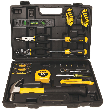Replacing a Sink Strainer
Written by Lee Wyatt (last updated September 18, 2020)
Do you happen to have a leak around your sink that you can't quite seem to place? The source of that leak may just be a little piece of equipment called the sink strainer. Every sink has this piece of equipment, since it is what attaches the sink to the drainage pipes. The only way to fix such a leak is to replace the equipment. Luckily replacing a sink strainer is a project that even a novice can accomplish with about an hours worth of work. All you need to do is follow these simple instructions.
Materials needed:
- Plumbers putty (for enamel sinks)
- Silicone caulking (for stainless steel or marble sinks)
- Gaskets
- Washers
- Water-pump pliers
- Hammer
- Caulking gun (if using silicone caulking)
- Plastic putty knife
- Basket strainer wrench
- Miniature hacksaw
- Screwdriver
Procedure:
- Prepare your workspace. In order to do this work, you will need to prepare your workspace. The best way to prepare the workspace that you will be using is by cleaning out the area underneath the sink. Remove any and all obstacles, cleaners, or other items that may be there.
- Remove the slip nuts. Use a pair of water-pump pliers to loosen the slip nuts. The slip nuts is the piece that attaches the pipe to the sink strainer assembly. Since the slip nut is made out of PVC, it is very easy to damage if too much pressure is used.
- Remove the locking nut. Take a basket strainer wrench, and remove the sink strainer assembly locknut. This is the metal ring that surrounds the sink strainer assembly, and can often be a little difficult to remove. If it doesn't want to budge, tap the ring with a hammer and screwdriver. Once loosened, remove the assembly from above and below the sink.
- Get rid of old putty. Clean off the old putty from the sink. If necessary scrape it away using a plastic putty knife. All of the old putty or caulking needs to be removed in order to create a tight seal with the new sealant. If you are going to be reusing the old assembly, make sure that you have removed all sealant from that as well, while also replacing any gaskets and washers that are on the assembly. Check to ensure that you also clean off any sealant underneath the sink as well.
- Apply sealant. The type of sealant that you apply to your new assembly depends solely on the type of sink that you have. If you have a marble or stainless steel sink then you need to use silicone caulking, while an enamel sink will require plumber's putty. If you are using plumbers putty, create a thin rope that is roughly 3/8 inch in diameter, and apply it to the flange of the assembly.
- Put the strainer back together. Remove any excess sealant under the sink by using a plastic putty knife, and then install a new gasket and friction ring. Hand tighten the metal locking ring of the sink strainer assembly. Reconnect the assembly to the drain pipes by replacing the slip nuts, once again make sure that you don't use too much pressure or you can crack the PVC. Test your work by filling the sink with water, and checking for any leaks. If there are no leaks you are finished.
Author Bio
Lee Wyatt
Contributor of numerous Tips.Net articles, Lee Wyatt is quickly becoming a regular "Jack of all trades." He is currently an independent contractor specializing in writing and editing. Contact him today for all of your writing and editing needs! Click here to contact. Learn more about Lee...
Dickering with the Dealer
The key to dickering with car dealers is to use their tactics against them. Here is the secret behind how you can do just ...
Discover More
Retaining Wall Renovations
When dealing with a new retaining wall, there is one thing that many people fail to consider. That problem is that ...
Discover More
Planning a Fruit Garden
It is never too late, or too early to begin planning any garden, let alone planning a fruit garden. By taking your time ...
Discover More
More Home Improvement Tips
Adjusting the Water Heater Temperature
One of the easiest, though slightly annoying, jobs that you can do around the home is adjusting the temperature of your ...
Discover More
Joining Plastic and Metal Plumbing
Learning the proper method of joining plastic and metal plumbing is an important skill that any do-it-yourself enthusiast ...
Discover More
Adjusting Water Heater Temperature
Adjusting the temperature of your water heater is as easy as moving the dial of your thermostat. The difficult part is ...
Discover More

Comments